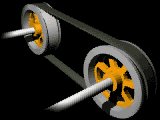Conveyor belt
[1] Products are conveyed directly on the belt so both regular and irregular shaped objects, large or small, light and heavy, can be transported successfully.However, in this case, the idler frame completely surrounds the conveyor belt helping it to retain the pipe section while pushing it forward.[9] In 1892, Thomas Robins began a series of inventions which led to the development of a conveyor belt used for carrying coal, ores and other products.[12] In 1972, the French society REI created in New Caledonia the longest straight-belt conveyor in the world in that moment, at a length of 13.8 km (8.6 miles).The longest conveyor belt is that of the Bou Craa phosphate mine in Western Sahara (1973, 98 km in 11 sections).Incorporating a half-twist, it had the advantage over conventional belts of a longer life because it could expose all of its surface area to wear and tear.The warp refers to longitudinal cords whose characteristics of resistance and elasticity define the running properties of the belt.The weft represents the whole set of transversal cables allowing to the belt specific resistance against cuts, tears and impacts and at the same time high flexibility.The most common carcass materials are steel, polyester, nylon, cotton and aramid (class of heat-resistant and strong synthetic fibers, with Twaron or Kevlar as brand names).Stores often have conveyor belts at the check-out counter to move shopping items, and may use checkout dividers in this process.Integration of Human-Machine Interface(HMI) to operate the conveyor system is in the developing stages and will prove to be an efficient innovation.It was built in 1972 by Friedrich Krupp GmbH (now thyssenkrupp) and is 98 km (61 miles) long, from the phosphate mines of Bu Craa to the coast south of El-Aaiun.[19] Boddington Bauxite Mine in Western Australia is officially recognized as having the world's longest single flight conveyor.[20] The longest single-belt international conveyor runs from Meghalaya in India to a cement factory at Chhatak Bangladesh.Dedicated vehicles were designed for the maintenance of the conveyor, which is always at a minimum height of 5 metres (16 ft) above the ground to avoid being flooded during monsoon periods.Applications for the material include toolbox liners,[26] anti-fatigue floor mats,[26] dock bumpers,[26] landscale edging,[26] livestock fencing,[26] and water diversion.

thermohaline circulationsulfurConveyor systemTransportationThomas Robinspulleyspulleymaterial handlingbulk material handlingoverburdenretailwholesalemanufacturingdistributionexpensebaggage handling systemssushi conveyor barelectrical motorBavariaPimlicograin elevatorreapersugarcane millssawmillsmaltingsSandvikRichard Sutcliffecoal minesHenry FordFord Motor CompanyBou CraaBoddingtonMöbius stripIntraloxpolyestercottonaramidTwaronKevlarChuquicamataYanzhou Coal Mining CompanyShenhua Groupbeltweigherconveyor transportmoving sidewalksescalatorsassembly linescheck-out countercheckout dividersSki areastransport skiersTarantoPaolo MontiWestern SaharaphosphateBu CraaEl-AaiunDubai International AirportSiemensWorsley AluminaBangladeshlimestonetrip cordsOccupational Safety and Health Administrationemergency stopsCheck weigherConveyor pulleyGrain binLineshaft roller conveyorTravelatorTensionerTreadmillThe New York TimesEncyclopedia AmericanaHounshell, David A.Johns Hopkins University PressWikisource1911 Encyclopædia Britannica